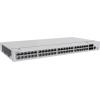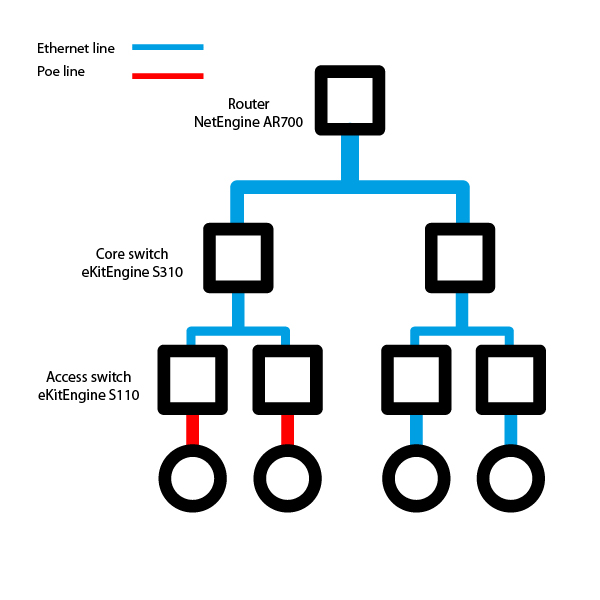-
zł



Huawei S310-48P4X es un switch gestionado de la serie eKitEngine. Está equipado con 48 puertos Gigabit Ethernet (10/100/1000 Mb/s) y 4 ranuras SFP+ (10 Gb/s). Hay una salida de alimentación PoE+ en todos los puertos Ethernet, la potencia máxima por puerto es de 15,4 W en 802.3af o 30 W en 802.3at. El presupuesto total de energía para todo el dispositivo es de 380 W, mucho más que las soluciones de la serie S110, más económica. El switch proporciona administración en Layer 2 y funciones básicas de Layer 3. Admite los protocolos Spanning Tree (STP / RSTP / MSTP) y el moderno estándar ERPS (Ethernet Ring Protection Switching). Tiene una función Smart Link que permite crear una conexión de respaldo. Puede conectar dispositivos de la serie S310 a muchos switches de agregación mediante múltiples conexiones, asegurando así el funcionamiento de la red en caso de daño a uno de los cables. El producto ofrecido se distingue por su seguridad avanzada, está protegido contra varios tipos de ataques (incluidos DoS, suplantación de IP/MAC e inundación SYN), utiliza vigilancia DHCP y recuerda las entradas ARP, lo que protege contra spoofing ARP. Una ventaja adicional es la compatibilidad con iStack: muchos switches se pueden apilar virtualmente en un solo dispositivo. La administración se realiza mediante la interfaz web UI, CLI o SNMP. El dispositivo admite gestión en la nube y la aplicación eKit. Dispone de fuente de alimentación AC integrada y refrigeración activa con ajuste inteligente de la velocidad del ventilador. S310-48P4X combina las funciones de un switch principal (core) y de acceso. Gracias a la fuente de alimentación PoE+, puedes conectar puntos de acceso directamente a ella, lo que será útil en redes pequeñas y medianas. Al mismo tiempo, no renuncia a la gestión avanzada que ofrece la serie de conmutadores S310. El uso de ranuras SFP+ permite crear hasta 4 conexiones con un ancho de banda de 10 Gb/s para conectar la señal de uplink o los dispositivos más importantes.
48 puertos gigabit Ethernet, 4 ranuras SFP+
El switch está equipado con 48 puertos Gigabit Ethernet (10/100/1000 Mb/s) y 4 ranuras SFP+ (10 Gb/s). La capacidad de conmutación es de 176 Gb/s y la velocidad de reenvío de paquetes es de 131 Mp/s. Las ranuras SFP+ proporcionan alta velocidad (hasta 10 Gb/s), lo que le permite conectar varios segmentos de red o dispositivos de alto rendimiento, como servidores.


48 salidas PoE+
Hay una salida de alimentación PoE+ en todos los puertos Ethernet. La potencia máxima de salida por puerto, según los estándares, es de 15,4 W en 802,3 af o 30 W en 802,3 at. El presupuesto total de energía para todo el dispositivo es de 380 W, mucho más que las soluciones de la serie S110. Suficiente para conectar 24 AP usando el estándar 802.3 af, en la mayoría de los casos puede conectar incluso más dispositivos, el consumo de energía suele ser inferior a 15 W.
El uso de PoE le permitirá proporcionar energía y transmisión de datos a través de un cable Ethernet. Gracias a este tipo de switch, sólo es necesario tender un cable a cada punto de acceso, no es necesario utilizar fuentes de alimentación adicionales.
Gestión Layer 2+, iStack
El dispositivo es totalmente compatible con la gestión de Layer 2 y, además, tiene funciones básicas de Layer 3, como el enrutamiento estático. Admite VLAN, multidifusión (IGMP Snooping, MLD Snooping), QoS y listas de control de acceso (ACL). Admite los protocolos Spanning Tree (STP / RSTP / MSTP) y el moderno estándar ERPS (Ethernet Ring Protection Switching) definido en el estándar IUT-T G.8032.
El switch proporciona la seguridad de red necesaria. Protege contra ataques DoS: inundación SYN, Land, Smurf e ICMP. También tiene protección contra ataques dirigidos a los usuarios: ataques al servidor DCHP, suplantación de IP/MAC, inundación de solicitudes DHCP o DHCP CHADDR.
La serie S310 admite la función iStack, se pueden apilar lógicamente varios conmutadores en un switch virtual. Esto facilita la gestión de la red y te permite crear conexiones de respaldo adicionales que te protegerán ante posibles fallos.
La gestión se realiza a través de la interfaz gráfica web, CLI o mediante SNMP (v1, v2c, v3)/SSH2.0. Los dispositivos de la serie S310 también se pueden administrar en la nube, en cuyo caso también puede utilizar la aplicación Huawei eKit.


Uso
S310-48P4X combina las características de un switch principal y de acceso. Tiene funciones de gestión avanzadas y soporta la función iStack, además, hay una salida de alimentación PoE en todos los puertos Ethernet. El dispositivo es perfecto para redes de oficina. Gracias al uso de hasta 48 puertos, puede conectar puntos de acceso u otros dispositivos habilitados para PoE a algunos de ellos y ordenadores, impresoras, etc. a otros. En algunas ubicaciones, el S310-48P4X será completamente suficiente. Para todos los usuarios, no necesitará utilizar switches adicionales. El uso de ranuras SFP+ permitirá la conexión de dispositivos clave con un ancho de banda de 10 Gb/s.
Especificación
| Huawei S310-48P4X | |
| Cambio de ancho de banda | 176 Gb/s |
| Velocidad de reenvío de paquetes | 131 Mp/s |
| Puertos |
48x gigabit Ethernet 10/100/1000 Mb/s z PoE+ 4x SFP+ (10 Gb/s) |
| Dimensiones | 43.6 mm x 442 mm x 220 mm |
| Altura | 1U |
| Peso | 4,29 kg |
| Modo de alimentación | Fuente de alimentación de AC incorporada |
| Tensión nominal de entrada | 100 - 240 V AC, 50/60 Hz |
| Rango de voltaje de entrada | 90 - 290 V AC, 55/65 Hz |
| Consumo máximo de energía |
Sin PoE: 64,7 W Con PoE: 462,8 W (presupuesto PoE: 380 W) |
| Volumen |
A temperatura normal: 49,3 dB (A) A alta temperatura: 63 dB (A) |
| Temperatura de funcionamiento permitida | De -5 a 50 C |
| Temperatura de almacenamiento permitida | De -40 a 70 C |
| Humedad del aire permitida | 5%-95% sin condensación |
| Protección contra sobretensiones para puertos de servicio | ± 10 kV |
| Protección contra sobretensiones del puerto de alimentación | ± 6 kV |
| Enfriamiento | Ajuste activo e inteligente de la velocidad del ventilador |
| Propiedades del software | |
|---|---|
| Tabla de direcciones MAC |
MAC automático address learning / aging Máx. 16K de direcciones MAC Estáticas/dinámicas / blackhole entradas de direcciones MAC Filtrado de dirección MAC de origen Límite de direcciones MAC recordadas por interfaz |
| VLAN |
4094 VLANs Voice VLAN MUX VLAN Asignación de VLAN basada en dirección MAC, protocolo, subred IP, política y puertos VLAN stacking |
| Ethernet switching |
Topología Smart Link tree y Smart Link multi-instance G.8032 ERPS (Ethernet Ring Protection Switching) STIP (IEEE 802.1d), RSTP (IEEE 802.1w), MSTP (IEEE 802.1s) Protección BPDU / root / antes de bucles Túnel BPDU |
| Multicasts | IGMP v1 / v2 / v3, IGMP v1 / v2 / v3 snooping y MLD snooping |
| Routing IP |
Routing estático y PBR (policy-based routing) Máx. 512 FIBv4 Máx. 512 FIBv6 |
| Propiedades de IPv6 |
ND (neighbor discovery) PMTU IPv6 ping, IPv6 tracert, IPv6 telnet |
| Estabilidad |
LACP (Link Aggregation Control protocol) VRRP (Virtual Router Redundancy Protocol) BFD (Bidirectional Forwarding Detection) LLDP (Link Layer Discovery Protocol) |
| Función QoS / control de acceso ACL |
Límite de tráfico basado en entrada/salida por puerto Redirección de paquetes Two-rate three-color CAR, enrutamiento de tráfico basado en puertos 8 rondas por puerto Algoritmos de cola: DRR, SP y DRR+SP Re-marking de prioridades 802.1p y DSCP para paquetes Filtrado de paquetes en Layer 2 - Layer 4, filtrado de tramas no válidas según la dirección MAC de origen, la dirección MAC de destino, la dirección IP de origen, la dirección IP de destino, el número de puerto TCP/UDP, el tipo de protocolo o VLAN Límite de ancho de banda por cola y configuración de tráfico por puerto Network slicing (VLAN/VXLAN) |
| Seguridad |
Gestión jerárquica de usuarios y protección con contraseña Protección contra ataques DoS, ARP e ICMP Asignar una dirección IP, una dirección MAC, un ID de puerto y un ID de VLAN Aislamiento de puertos, seguridad de puertos, MAC fija Autenticación IEEE 802.1X y límite de usuario por puerto Múltiples métodos de autenticación, incluidos AAA, RADIUS, HWTACACS y NAC SSH v2.0 HTTPS Protección CPU Lista blanca y negra Cliente DHCP, DHCP relay, DHCP servidor, DHCP snooping Cliente DHCPv6, DHCPv6 relay |
| Gestión y mantenimiento de redes |
iStack Gestión de la nube basada en NETCONF/YANG VCT (Virtual cable test) Gestión y mantenimiento remoto de redes mediante Telnet SNMP v1/v2/v3 RMON Gestión a través del sistema Web HTTPS LLDP/LLDP-MED Registros y alarmas del sistema IEEE 802.3az EEE (Energy Efficent Ethernet) Puerto mirroring Ampliación de la red mediante registration query center |
| Interoperabilidad |
VBST Cooperación con PVST, PVST+ y RPVST |






 Polski
Polski English
English Italiano
Italiano Español
Español Čeština
Čeština Српски
Српски Deutsch
Deutsch Ελληνικά
Ελληνικά Slovenský
Slovenský









